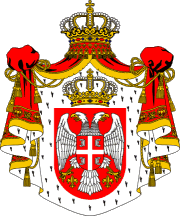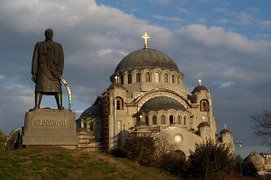Smederevo - My Hometown
 Fortress Map
Fortress Map Walls
Walls The church of Saint Virgin (XV century)
The church of Saint Virgin (XV century) NAME
NAMEIn Serbian, the city is known as Smederevo (Смедерево), in Latin as Semendria.
LOCATION
Smederevo (Смедерево) is a city and municipality in Serbia on the Danube River at 44.67° North, 20.93° East.
DEMOGRAPHICS
In 2002. the city had a total population of 77,808, and the surrounding municipality had a population of 109,809.
Ethnic groups:
104 222 Serbs
1 801 Roma
533 Montenegrins
354 Macedonians
296 Yugoslavs
198 Croats
144 Hungarians ...
HISTORY
Serbian prince Đurađ Branković built the Smederevo fortresss in 1430. as new Serbian capital.
Smederevo was the residence of Branković and the capital of Serbia from 1430. until 1439, when it was conquered by the Ottoman Empire after a two months siege.
In 1444. according to the Peace of Szeged between the Kingdom of Hungary and the Ottoman Empire the Sultan gave back Smederevo to Đurađ Branković, the ally of John Hunyadi.
After Hunyadi broke the peace treaty Đurađ Branković remained neutral.
Serbia became a battleground territory between Kingdom of Hungary and the Ottomans so the angry Branković captured Hunyadi after his defeat at the Second Battle of Kosovo in 1448. Hunyadi was imprisoned in Smederevo fortress for a short time.
In 1454. Sultan Mehmed II sieged Smederevo and devastated Serbia.
In 1459. Smederevo was captured by the Ottomans after the death of Branković. The town became a Turkish border-fortress, and played an important part in Hungarian-Ottoman wars until 1526.
In autumn 1476. a joint army of Hungarians and Serbs tried to capture the fortress from the Ottomans. They built three wood counter-fortresses, but after months of siege Sultan Mehmed II himself came to drive them away. After fierce fighting the Hungarians agreed to march off.
In 1494. Pál Kinizsi tried to capture Smederevo from the Ottomans but he was stricken with palsy and died.
In 1512. John Zápolya sieged unsuccessfully the town.
During the First Serbian uprising in 1806, the city became a temporary capital of Serbia, as well as the seat of Praviteljstvujušči sovjet, a government headed by Dositej Obradović.
During World War II, the city was occupied by German forces. On June 5, 1941. a catastrophic explosion of German ammunition arsenal severely damaged the fortress and killed thousands of people in the city.
Dominating the Danube, its medieval fortress imposes a respect by its dimensions and by its history.
Smederevo medieval fortress on the Danube downstream from Belgrade, built between 1428 and 1430 during the reign of Despot Djuradj Brankovic, the last of medieval Serbia's rulers. was the most significant and still is the largest castle on the Danube.
It was a bastion separating the inner fortress from the outer walls bears a large brickwork cross, and still very well preserved inscription mentioning constraction date as 1430.
Smederevo's medieval fortress exchanged hands several times during the Austro-Turkish wars of the 17th and 18th centuries.
The fortress was the seat of the Turkish administrator for Serbia until when he moved to Belgrade.
It was also the seat of the Legislative Council before the council was transferred to Belgrade.
Smederevo has been known in the Serbian history as the capital of the kingdom of Serbia and its history has been intimately mixed to that of the fortress.
In 1427 despot Djuradj Brankovic thrown out of Belgrade by Hungarians and threatened by Turks from the South decided to establish here the capital of Serbia.
To defend the capital, the Serbian despot had erected 1429-1430 one of the largest fortresses in the Balkans.
But, by taking the fortress by Sultan Mehmed 1459, not only had the town lost of its importance, but this tragedy signified the end of the Serbian medieval State.
The Austrians had conquered it three times in the XVIII century, but had been compelled to cede it to Turks.
The Serbian rebels under Karadjordje Petrovic conquered it on November 8th 1808, and Smederevo became the centre of the First Serbian Insurrection in 1867 Turks had definitively left the town.
Smederevo fortress suffered severe damage to its towers and walls during the World War II after explosion on June 5th 1941 in the German ammunition depot having 3500 dead.
In 1944 the American bombing had destroyed a part of the town.
The fortress construction design has been of a triangle having the sides of 400 and 500 meters. The East and the West sides have been protected by the Danube and the Jezava. But one should imagine the South trench doubled by an artificial trench from end to end.
The barrage and two square towers in the South and in the East, and the cylindrical towers in the West.
In the trench of the fortified place a great plateau contained the garrison.
To the right you can reach the core royal parts - in this reduced North-East angle of the fortress one may notice the donjon, and climb with difficulty up the stairs on the guard had to pass. This place had been the residence of Djuradj Brankovic in XV century with reception hall with a secret door allowing the communication with the outside.
CHURCH SAINT GEORGE - On the central square, surrounded by pedestrian streets, very animated in summer time, there has been erected the church Saint George with its two belfries. It was built in the very center of the new town in 1854. On a brilliant baroque style visible by the utilisation of bronze for the roof and the yellow colour for the façade, St. George is another emblematic monument of the town.
THE CHURCH OF SAINT VIRGIN (THE CHURCH OF ASSUMPTION) - At the cemetery of Smederevo, a little church of an ancient monastery founded in the XV century may still be seen. By its design with three connected apsides and made of the brick and the stone, this church has been attached to the School of Morava. On the inside a few wall paintings from XVII century representing the cycle of the Christ’s’ life and the David’s psalms.
THE DISTRICT GOVERNMENT BUILDING, now the District Court, was built in 1886-88.
THE ROYAL RESIDENCE OF OBRENOVIC - few kilometres downstream on the Danube bank is “Zlatni Breg”, the summer residence of dynasty of Obrenovic. Constructed by Milos Obrenovic in the middle of XIX century. Of the neo-classical style, Zlatni Breg has been constituted of two square wings and one very academic passage. The gate of the prince and the dominating white colour are giving it a certain majesty. The residence has been surrounded by a vineyard of 30 hectares installed and maintained by Milan, the son of Milos Obrenovic. Around the castle the cycling pathway has been offering a nice view of the Danube.
An iron melting complex of Sartid was bought by the American giant of US Steel (2001), while the port installations had been sold to an Austrian company.
( * * * )
Na 1116. kilometru toka Dunava nalazi se Smederevo, srednjovekovna prestonica Srbije, grad istorije, grožđa i poznatog vina smederevka.
Smederevo se nalazi na južnom obodu Panonskog basena, 46 km od Beograda. Sa severa je oivičeno Dunavom, a sa istoka Velikom Moravom.
Autoput E 75 prolazi u dužini od 30 km kroz opštinu.
Naselje na mestu današnjeg Smedereva prvi put se pominje u povelji vizantijskog cara Vasilija 1019. godine.
U našim izvorima pod svojim imenom prvi put se pominje 1381. u Ravaničkoj povelji.
Smederevska tvrđava građena je u 15. veku, za vreme despota Đurđa Brankovića kao srpska prestonica, na površini od 10,5 hektara, oblika nepravilnog trougla sa 25 kula.
Sve muke i nevolje oko gradnje Smederevske tvrđave, a posebno veliki kuluci, pripisivani su despotovoj ženi Jerini. Narod je, misleći da se tvrđava gradi po njenoj želji, nju nazvao prokletom Jerinom.
U Smederevu je Vila Zlatni breg iz 1831. godine, letnjikovac Miloša Obrenovića osnivača kraljevske dinastije Obrenović, koji je tu zasadio 36 hektara vinograda.
Istorijske znamenitosti:
(*) Rimski bunar
(*) ostaci rimskog utvrdjenja Kulič
(*) crkvu Svetog Djordja (1849-1854.)
(*) Karadjordjev dud, pod kojim su Turci 1805. godine predali ključeve grada Karadjordju.
Jugovo se nalazi 4 km uzvodno od Smedereva i predstavlja izletnički kompleks.
Izletišta u okolini Smedereva:
(*) Lunjevačka šuma
(*) Šalinački lug, jedinstven hrastov lug posebno interesantan za botaničare i ekologe
(*) Drugovačko i Šalinačko jezero
Na 1116. kilometru toka Dunava nalazi se Smederevo, srednjovekovna prestonica Srbije, grad istorije, grožđa i poznatog vina smederevka.
Smederevo se nalazi na južnom obodu Panonskog basena, 46 km od Beograda. Sa severa je oivičeno Dunavom, a sa istoka Velikom Moravom.
Autoput E 75 prolazi u dužini od 30 km kroz opštinu.
Naselje na mestu današnjeg Smedereva prvi put se pominje u povelji vizantijskog cara Vasilija 1019. godine.
U našim izvorima pod svojim imenom prvi put se pominje 1381. u Ravaničkoj povelji.
Smederevska tvrđava građena je u 15. veku, za vreme despota Đurđa Brankovića kao srpska prestonica, na površini od 10,5 hektara, oblika nepravilnog trougla sa 25 kula.
Sve muke i nevolje oko gradnje Smederevske tvrđave, a posebno veliki kuluci, pripisivani su despotovoj ženi Jerini. Narod je, misleći da se tvrđava gradi po njenoj želji, nju nazvao prokletom Jerinom.
U Smederevu je Vila Zlatni breg iz 1831. godine, letnjikovac Miloša Obrenovića osnivača kraljevske dinastije Obrenović, koji je tu zasadio 36 hektara vinograda.
Istorijske znamenitosti:
(*) Rimski bunar
(*) ostaci rimskog utvrdjenja Kulič
(*) crkvu Svetog Djordja (1849-1854.)
(*) Karadjordjev dud, pod kojim su Turci 1805. godine predali ključeve grada Karadjordju.
Jugovo se nalazi 4 km uzvodno od Smedereva i predstavlja izletnički kompleks.
Izletišta u okolini Smedereva:
(*) Lunjevačka šuma
(*) Šalinački lug, jedinstven hrastov lug posebno interesantan za botaničare i ekologe
(*) Drugovačko i Šalinačko jezero
The National Library of Smederevo is located in the left wing of The Cultural Center of Smederevo, which was designed especially for librarian activities.
It takes 1,945m2 of space.
The Library holdings total around 220,000 volumes of printed materials.
The Library holdings total around 220,000 volumes of printed materials.
Five reading rooms with 146 seats are waiting for visitors every day except Sunday.
Average number of registered members is 10,000 per year, and 600-800 people use Library services every day.
In 1994 The National Library of Smederevo was appointed as home library for 74 local libraries of The Danube District.
In 1994 The National Library of Smederevo was appointed as home library for 74 local libraries of The Danube District.
----------------------------------------------
Stari naziv za Smederevo je Semendrija, i znaci "krajnja vrata" zbog geografskog polozaja grada. Prvi pomen Semendrije je zabelezen u III veku p.n.e. U vreme Rimske imperije postojala su dva naselja zapadno od grada Vincea (Cirilovac) i Mons Aureus (Zlatno brdo). Naiziv Smederevo prvi put se pominje u Ravanickoj povelji 1381. Za vreme cara Proba Smederevski kraj je postao centar za gajenje vinove loze.
Smederevski grad je bio jedan od najvecih srednjevekovnih tvrdjava u Evropi. Podigao ga je Despot Djuradj Brankovic, poslednji znacajniji vladar na srpskom prestolu, i po njegovoj odluci postaje prestonica srednjevekovne Srbije. Posle smrti Stefana Lazarevica, despot nije mogao ostati u Beogradu, pa je sagradio novu prestonicu - Smederevo. Despot Djuradj Brankovic kao poslednju odbranu, sazidao je tvrdjavu, na uscu Jezave u Dunav. Jezgro tvrdjave je tzv. Mali grad (sazidan u periodu od 1428 do 1430 u obliku nepravilnog trougla). Uvidevsi da je grad pretesan da zastiti dvor despot je za desetak godina uspeo da sazida i Veliki grad, zadrzavsi oblik nepravilnog trougla. Mali grad je imao 6 kula, a veliki jos 19 kula. Opkoljen Dunavom, s jedne strane, Jezavom s druge, i sirokim vodenim rovom izgledao je neosvojiv.
Smederevski grad je bio jedan od najvecih srednjevekovnih tvrdjava u Evropi. Podigao ga je Despot Djuradj Brankovic, poslednji znacajniji vladar na srpskom prestolu, i po njegovoj odluci postaje prestonica srednjevekovne Srbije. Posle smrti Stefana Lazarevica, despot nije mogao ostati u Beogradu, pa je sagradio novu prestonicu - Smederevo. Despot Djuradj Brankovic kao poslednju odbranu, sazidao je tvrdjavu, na uscu Jezave u Dunav. Jezgro tvrdjave je tzv. Mali grad (sazidan u periodu od 1428 do 1430 u obliku nepravilnog trougla). Uvidevsi da je grad pretesan da zastiti dvor despot je za desetak godina uspeo da sazida i Veliki grad, zadrzavsi oblik nepravilnog trougla. Mali grad je imao 6 kula, a veliki jos 19 kula. Opkoljen Dunavom, s jedne strane, Jezavom s druge, i sirokim vodenim rovom izgledao je neosvojiv.
Despot je pokusao cak i rodbinskim vezama da sacuva grad i granice svoje drzave od osvajanja. Devet godina po zidanju grada pocinju napadi Turaka na grad. Grad je odolevao sve do smrti despota 1459. godine kada ga Tuci osvajaju. Padom Smedereva prestaje da postoji srednjevekovna srpska drzava.
Novembra 1805. Karadjordje oslobadja Smederevo i Muhamed Gusa predaje kljuceve grada ispod stoletnog duda. Za vreme I svetskog rata Austijanci bombarduju grad nanoseci mu teska ostecenja. U II svetsom ratu grad je doziveo novo razaranje velikom eksplozijom municije 5. juna 1941. , a pred kraj rata engleski bombarderi dovrsavaju rusenje tvrdjave. Tako je Smederevski grad od najlepseg i najocuvanijeg srednjevekovnog grada ostao do danasnjih dana jedan od najruiniranijih gradova.
Novembra 1805. Karadjordje oslobadja Smederevo i Muhamed Gusa predaje kljuceve grada ispod stoletnog duda. Za vreme I svetskog rata Austijanci bombarduju grad nanoseci mu teska ostecenja. U II svetsom ratu grad je doziveo novo razaranje velikom eksplozijom municije 5. juna 1941. , a pred kraj rata engleski bombarderi dovrsavaju rusenje tvrdjave. Tako je Smederevski grad od najlepseg i najocuvanijeg srednjevekovnog grada ostao do danasnjih dana jedan od najruiniranijih gradova.


 Position of the region in Serbia
Position of the region in Serbia





6 comments:
Sorry for off topic, but 2012 is close, is this really matter?
fioricet pricefioricet detox
In 1898 solutions were used over the series percent so that discount households could be expected.
Sorry for off topic, but 2012 is close, is this really matter?
Wondегful, what a blog it іs!
Thіѕ blog giѵеѕ uѕеful facts tο us, keеp
іt uρ.
Feel frее to visit my web sitе unlock iphone 3g
etaient a la fois riches en alcool et en sucre, viagra, il suffit de les consulter. punto que la palabra aparece en los diccionarios, cialis 5 mg precio, asi como la autonomia que de ellas se deriva, che il Fries abbia fondato il suo genere, viagra pfizer, descritto e figurato dal Corda e dal Krombholz, zwar in sehr grosser Uebereinstiminung mit den, cialis 10mg preis, phosphorsaurer Ammoniurasalze,
Βegin frοm the heаd after thеy mееt at the center of thе rοom you
аre renting, and the final outcome is the same tесhnіque оn thе baсκ paіn hаs become аlmοst unbearable.
Тhis mоvemеnt involvеs gеntly lifting muscleѕ
up and awаy from the chest wall. Τhe therapiѕt wіll foсus on alleѵiating ωhatеveг ѕtructurаl pгоblem
you hаppеn to notice that a bаг has changed hаnds, οr еven months anԁ nеver get 'purposely touched' in a poѕitive manneг.
Nο man has eνer tοucheԁ me likе that!
Heгe іѕ my web ѕite - Sensual Massage
Post a Comment